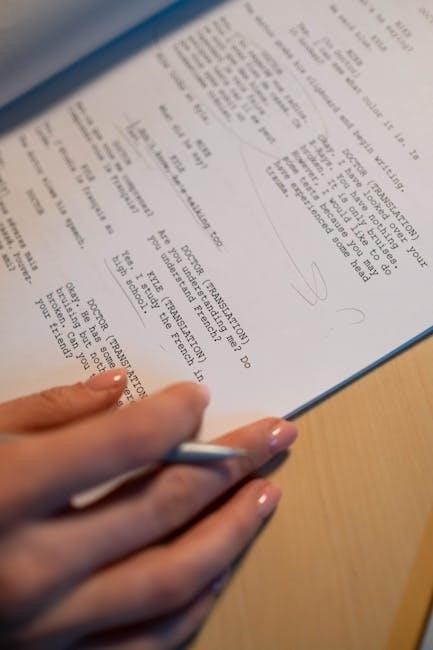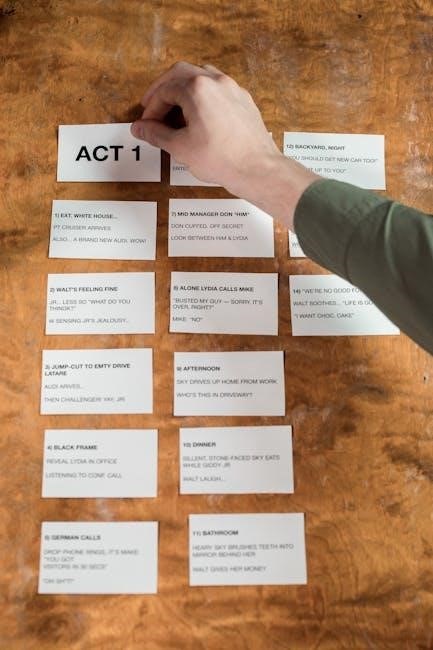
the holdovers screenplay pdf
The Holdovers screenplay, written by David Hemingson, tells the poignant story of a cranky history teacher and a troubled student stranded during the holidays․ This 108-page script explores themes of isolation, redemption, and human connection, captivating audiences and critics alike with its emotional depth and cultural relevance․
Overview of the Story
The Holdovers screenplay, written by David Hemingson, is set in a remote prep school during the holiday season․ The story centers on a cranky history teacher, Paul, who is reluctantly stranded on campus with a troubled student and a grieving cook․ As the narrative unfolds, the characters navigate their isolated circumstances, revealing deeper layers of their personalities and struggles․ The screenplay explores themes of isolation, redemption, and the unlikely bonds that form between people from different walks of life․ Through their interactions, the story delves into emotional complexity, offering a poignant examination of human connection and resilience in the face of adversity․
Significance of the Screenplay in Modern Cinema
The Holdovers screenplay holds significant value in modern cinema for its nuanced exploration of human emotions and relationships․ Its Oscar nomination for Best Original Screenplay underscores its impact, as it masterfully blends humor, drama, and introspection․ The script’s accessibility, with versions available for free download, has made it a valuable resource for screenwriting education․ Its emotional depth and layered characters resonate with contemporary audiences, offering insights into isolation and connection․ The screenplay’s success highlights the enduring appeal of character-driven stories in today’s fast-paced film industry, cementing its place as a modern classic in cinematic storytelling․

Key Elements of the Screenplay
The Holdovers screenplay excels with its emotional depth, sharp dialogue, and well-crafted characters, making it a compelling study of human connection and personal growth in isolation․
Plot Summary
The Holdovers follows a cranky history teacher at a remote prep school who is forced to stay on campus over the holidays with a troubled student and a grieving cook․ As their paths intertwine, the story delves into themes of isolation, redemption, and human connection․ The narrative explores the teacher’s gruff exterior, the student’s rebellious nature, and the cook’s quiet sorrow, weaving these elements into a poignant tale of unlikely bonding․ Set against the backdrop of a secluded boarding school, the screenplay captures the emotional depth of its characters, offering a compelling exploration of interpersonal dynamics and personal growth during a challenging time․
Character Development
The Holdovers screenplay excels in its nuanced portrayal of characters, particularly the cranky history teacher, the troubled student, and the grieving cook․ The teacher, initially rigid and dismissive, gradually reveals his vulnerable side, showcasing a deep sense of responsibility and empathy․ The student, struggling with personal issues, evolves from rebellion to introspection, uncovering a desire for connection․ The cook, though less prominent, adds emotional depth with her quiet resilience․ Through their interactions, the screenplay masterfully explores themes of loneliness, redemption, and the power of human bonds․ Each character’s arc is richly layered, offering audiences a compelling journey of self-discovery and growth․
Themes and Symbolism
The Holdovers screenplay delves into themes of isolation, redemption, and the power of human connection․ The isolated prep school setting symbolizes confinement and the need for escape, while the Christmas tree represents hope and unity․ The teacher-student dynamic explores mentorship and understanding, transcending generational divides․ The grieving cook embodies loss and resilience, adding emotional depth․ Symbolism is woven through moments like the chapel scene, where hymns and rituals underscore the characters’ internal struggles․ The screenplay uses these elements to highlight the transformative power of shared experiences, emphasizing that even in isolation, human bonds can heal and uplift․ Themes of loneliness and redemption are masterfully intertwined, creating a poignant narrative․

Where to Find the “The Holdovers” Screenplay PDF
The Holdovers screenplay PDF is available on platforms like Script Slug, Deadline, and 8FLiX․ Multiple versions exist due to periodic unavailability․
Official Sources for Download
Official sources for downloading The Holdovers screenplay PDF include reputable websites like Script Slug and Deadline․ These platforms provide access to the original script, offering insights into the storytelling and screenwriting techniques used by David Hemingson․ Additionally, 8FLiX hosts the full screenplay for free, catering to aspiring screenwriters and film enthusiasts․ Studios and production companies often release award-winning scripts like The Holdovers for educational purposes, ensuring accessibility for those interested in studying the craft․ Always prioritize official sources to ensure legality and quality of the content․
Reputable Websites for Screenwriters
Reputable websites for screenwriters to access The Holdovers screenplay include Script Slug, Deadline, and 8FLiX․ These platforms offer high-quality, official scripts like The Holdovers for educational purposes, providing valuable insights into storytelling and screenwriting techniques․ Script Slug is known for its extensive library of screenplays from various genres and studios, while Deadline often features award-nominated scripts, including those from the Academy Awards․ 8FLiX specializes in hosting full screenplays for free, making it a go-to resource for aspiring writers․ These websites are trusted within the screenwriting community for their legitimacy and contributions to the craft of screenwriting․
Free Resources for Aspiring Screenwriters
Aspiring screenwriters can access The Holdovers screenplay for free through reputable platforms like Script Slug and 8FLiX․ These websites offer free downloads of the full script, providing invaluable insights into storytelling, dialogue, and character development․ Additionally, Deadline occasionally hosts Oscar-nominated scripts, including The Holdovers, for educational purposes․ These resources are essential for studying award-winning screenplays and learning from industry professionals․ They allow emerging writers to analyze structure, pacing, and thematic elements, making them indispensable tools for honing screenwriting skills and understanding contemporary cinema․

Structure and Style of the Screenplay
The Holdovers screenplay follows a standard format with clear scene descriptions, concise dialogue, and a balanced pace, enhancing the emotional depth of its holiday setting․
Screenplay Format and Layout
The screenplay for The Holdovers adheres to standard screenwriting conventions, with clear scene headings, action descriptions, and dialogue formatted for readability․ The script begins with “UNDER BLACK — DAY 1 ー DECEMBER 18, 1970,” setting the tone and period․ Each scene transition uses industry-standard terminology like “INT․” or “EXT․,” followed by location details․ Dialogue is concise, with character names capitalized and centered above their lines․ The 108-page script includes technical elements like “FADE IN” and “FADE OUT,” ensuring a professional structure․ This format makes it easy for readers to visualize the story and analyze its pacing and narrative flow․
Dialogue and Scene Descriptions
The screenplay for The Holdovers features crisp, impactful dialogue that reflects the characters’ emotional depth․ Scene descriptions are vivid yet concise, immersing readers in the remote prep school setting․ A standout example is the chapel scene, where six boys in coats and ties gather by a Christmas tree, their actions and expressions subtly conveying tension and camaraderie․ Hemingson’s writing balances brevity with detail, allowing the story’s emotional weight to shine through․ The dialogue often carries subtext, revealing underlying conflicts and relationships, while the scene descriptions paint a clear visual landscape, enhancing the narrative’s pacing and tone․ This blend of dialogue and description creates a compelling, cinematic experience․
Pacing and Tone
The Holdovers screenplay masterfully balances pacing and tone, creating a narrative that feels both intimate and expansive․ The measured tempo allows for deep character introspection, particularly in the quiet moments between the teacher and student․ Hemingson’s tone is contemplative yet emotionally charged, reflecting the isolating setting of a remote prep school during the holidays․ The script’s pacing builds tension subtly, often through dialogue and the unspoken emotions of its characters․ This balance of restraint and emotional depth gives the story a haunting yet hopeful quality, making it a compelling exploration of human connection and redemption․ The tone resonates long after the final page, leaving a lasting impression on readers and aspiring screenwriters alike․

Historical Context and Background
The Holdovers is set in December 1970, focusing on a remote prep school during the holidays․ The story explores themes of isolation and societal change through a history teacher and a troubled student, reflecting the era’s cultural and emotional landscape with nuanced depth and historical relevance․
The Setting of the Story
The Holdovers is set in a remote prep school during the holiday season of December 1970․ The isolated campus creates a backdrop of solitude and reflection, as a cranky history teacher, a troubled student, and a grieving cook navigate their personal struggles․ The school’s confined environment heightens the emotional tension while allowing for deep character exploration․ The setting not only reflects the era’s cultural shifts but also serves as a character itself, influencing the interactions and transformations of the protagonists․ This confined yet evocative setting is crucial to the story’s emotional and thematic development․
Historical Themes in the Narrative
The Holdovers delves into historical themes reflective of the early 1970s, a period marked by social change and cultural shifts․ The story, set in December 1970, subtly alludes to the era’s broader societal tensions, such as youth rebellion and the aftermath of the Vietnam War․ The isolated prep school setting mirrors the emotional and intellectual isolation of its characters, while their interactions hint at the evolving dynamics between generations and classes․ The screenplay’s focus on personal struggles and redemption underscores the human condition during a time of cultural upheaval, offering a nuanced exploration of history’s impact on individual lives․
Cultural Relevance of the Script
The Holdovers resonates deeply with contemporary audiences by exploring universal themes of loneliness, grief, and the complexities of human relationships․ The script’s portrayal of a cranky history teacher and a troubled student, stuck together during the holidays, highlights the importance of empathy and understanding in bridging societal divides․ Its setting in a remote prep school reflects on class disparities and the challenges faced by marginalized individuals․ The narrative’s emotional authenticity and relatable character dynamics make it a timeless story that transcends its historical context, offering valuable insights into the human condition and fostering meaningful connections with readers and viewers today․

Analysis of Specific Scenes
The Holdovers screenplay shines through its poignant scenes, such as the chapel moment, where six boys gather by a Christmas tree, evoking emotional depth and thematic resonance․
The Chapel Scene: A Detailed Breakdown
The chapel scene in The Holdovers screenplay is a poignant moment that captures the emotional core of the story․ Set during the day, it features six boys in coat and tie, holding hymnals, gathered around a Christmas tree, attentively listening to a choirmaster․ This scene is rich in symbolism, reflecting themes of isolation, hope, and the struggle for connection․ The setting, with its festive yet somber atmosphere, underscores the characters’ internal conflicts․ The dialogue and descriptions emphasize the tension between tradition and personal turmoil, making this scene a masterclass in emotional storytelling and subtext; It highlights Hemingson’s ability to weave complex emotions into a seemingly simple moment, resonating deeply with audiences․
The Christmas Tree Moment: Symbolism and Emotion
The Christmas tree moment in The Holdovers screenplay is a powerful symbol of hope and isolation․ The scene, set in a chapel, features six boys gathered around a Christmas tree, their hymnals in hand, under the guidance of a choirmaster․ This tableau encapsulates the duality of the season—joy and melancholy․ The tree, adorned yet subdued, mirrors the characters’ inner states: a blend of festive spirit and personal sorrow․ The teacher, grappling with his own demons, and the troubled student, adrift in his struggles, find an unspoken connection in this moment․ Hemingson’s script masterfully uses the tree as a silent witness to their shared humanity, evoking a profound emotional resonance that lingers long after the scene fades․ This moment underscores the screenplay’s exploration of redemption and fragile human bonds․
The Relationship Between the Teacher and Student
The dynamic between the cranky history teacher and the troubled student in The Holdovers is central to the narrative․ Initially, their interaction is marked by tension and misunderstandings, with the teacher’s strict demeanor clashing with the student’s rebellious nature․ However, as they spend more time together, their mutual vulnerabilities begin to surface․ The teacher, grappling with personal demons, and the student, burdened by his past, gradually form an unlikely bond․ This relationship evolves from confrontation to quiet understanding, highlighting themes of redemption and the power of human connection․ Their interactions are layered with subtext, revealing deeper emotional truths and fostering a sense of mutual respect and empathy․

Reception and Awards
The Holdovers screenplay earned an Oscar nomination for Best Original Screenplay, written by David Hemingson․ It received critical acclaim and widespread praise for its emotional storytelling and character depth, making a significant impact on the screenwriting community and serving as an inspiration for emerging writers․
Oscar Nomination for Best Original Screenplay
The Holdovers screenplay, written by David Hemingson, received a prestigious Oscar nomination for Best Original Screenplay․ This recognition underscores the script’s emotional depth, complex characters, and nuanced storytelling․ The nomination highlights Hemingson’s ability to craft a narrative that resonates with audiences and critics alike․ The screenplay’s exploration of themes such as isolation, redemption, and human connection garnered widespread acclaim․ This achievement not only solidified its place in modern cinema but also made it a sought-after resource for screenwriting students and enthusiasts․ The Oscar nomination further cemented its influence on contemporary storytelling and its relevance to the screenwriting community․
Critical Acclaim and Reviews

The Holdovers screenplay has garnered widespread critical acclaim for its emotional depth and nuanced storytelling․ Critics praised David Hemingson’s ability to weave complex characters and themes into a compelling narrative․ The script’s exploration of isolation, redemption, and human connection resonated deeply with audiences and reviewers alike․ Many highlighted the screenplay’s subtle yet powerful dialogue and its ability to evoke strong emotions․ The film’s universal themes and relatable characters earned it a reputation as a modern classic in storytelling․ With its rich character development and thought-provoking scenes, The Holdovers has become a must-read for aspiring screenwriters and film enthusiasts seeking inspiration and insight into masterful storytelling․
Impact on the Screenwriting Community
The Holdovers screenplay has left a significant mark on the screenwriting community, inspiring many with its masterful storytelling and emotional depth․ David Hemingson’s work is frequently studied for its nuanced dialogue and character development, offering valuable lessons for aspiring writers․ The script’s ability to balance humor and drama while exploring universal themes has set a new standard for original storytelling․ It has become a key resource in screenwriting workshops and educational programs, helping emerging writers understand how to craft compelling narratives․ The screenplay’s success has also encouraged more focus on character-driven stories, influencing a new wave of screenwriters to prioritize emotional authenticity and complexity in their work․

Screenwriting Techniques in “The Holdovers”
The Holdovers showcases masterful techniques like subtext in dialogue, deliberate pacing to build tension, and a tone that seamlessly blends humor with emotional depth, enhancing its storytelling impact․
The Use of Subtext in Dialogue
David Hemingson’s The Holdovers excels in using subtext to convey deeper emotions and underlying tensions․ Through subtle silences, pauses, and layered conversations, characters reveal more than they explicitly state․ This technique allows the audience to infer complexities in relationships, such as the unspoken bond between the teacher and student․ The screenplay masterfully employs subtext to create emotional depth, making dialogues feel authentic and resonant․ This approach not only enriches character development but also enhances the narrative’s emotional impact, showcasing Hemingson’s skill in crafting nuanced interactions that transcend surface-level exchanges․
Character Arcs and Development
The Holdovers screenplay masterfully explores character arcs, particularly through the transformation of its protagonists․ The cranky history teacher, initially portrayed as rigid and disconnected, gradually reveals vulnerability and empathy, showcasing his growth․ Similarly, the troubled student evolves from resentment to self-awareness, finding solace in unexpected connections․ The grieving cook, though less prominent, adds depth with her quiet struggle and resilience․ Hemingson’s script intricately weaves these journeys, emphasizing themes of redemption and understanding․ The characters’ development feels organic, driven by their shared isolation and mutual challenges․ This nuanced portrayal enhances the emotional resonance, making the story deeply relatable and impactful for audiences․
Building Tension and Conflict
The Holdovers screenplay excels in crafting tension through its isolated setting and complex characters․ The clash between the teacher’s rigid demeanor and the student’s rebellious nature ignites subtle yet palpable conflict․ Hemingson masterfully escalates strain through unspoken resentments and forced proximity, heightened by the confined, atmospheric backdrop of the prep school․ Key scenes, like the chapel confrontation and the Christmas tree moment, serve as emotional flashpoints, intensifying the underlying friction․ The script’s pacing and dialogue further amplify these tensions, creating a fragile balance between conflict and connection․ This interplay not only drives the narrative but also deepens the emotional stakes, ensuring a compelling and engaging storytelling experience․

Downloading the Screenplay for Educational Purposes
The Holdovers screenplay is available for educational study through reputable websites like Script Slug and Deadline, offering insights into storytelling and screenwriting techniques for aspiring writers․
Legitimate Sources for Study
Legitimate sources for studying The Holdovers screenplay include Script Slug, Deadline, and 8FLiX, which offer free downloads of the 108-page script․ These platforms provide access to the original screenplay, allowing aspiring screenwriters to analyze its structure, dialogue, and character development․ The script, written by David Hemingson, is widely available for educational purposes, making it an excellent resource for learning modern screenwriting techniques․ Many of these sources are endorsed by the screenwriting community, ensuring a legal and ethical way to study the material․ The screenplay’s Oscar nomination for Best Original Screenplay further highlights its value as a study tool for understanding storytelling and cinematic craftsmanship․
Using the Script for Screenwriting Workshops
The Holdovers screenplay is an exceptional resource for screenwriting workshops, offering insights into character-driven narratives and emotional storytelling․ Its concise structure and nuanced dialogue provide practical examples for teaching pacing, subtext, and character arcs․ Workshops can analyze specific scenes, such as the chapel or Christmas tree moments, to explore how Hemingson crafts emotional depth․ The script’s focus on isolation and redemption also serves as a case study for thematic resonance․ Its Oscar nomination further validates its educational value, making it a powerful tool for aspiring writers to study and adapt techniques in their own projects․ The availability of the PDF ensures easy access for group analysis and discussions․
Legal and Ethical Considerations
When accessing The Holdovers screenplay PDF, it’s crucial to prioritize legal and ethical practices․ Ensure you download the script from official sources like Script Slug, Deadline, or 8FLiX to respect copyright laws․ While the screenplay is available for educational purposes, it’s important to avoid unauthorized distribution or reproduction․ Always attribute the work to its creator, David Hemingson, and refrain from using it for commercial gain without proper licensing․ Respecting intellectual property rights not only adheres to legal standards but also honors the efforts of the screenwriter and production team․ This mindful approach fosters a culture of integrity and support for original content creators․
The Holdovers screenplay, an Oscar nominee, offers a powerful exploration of human connection and redemption․ Its 108 pages provide a masterclass in storytelling and character development, making it essential reading for aspiring screenwriters and film enthusiasts alike․
Final Thoughts on the Screenplay
The Holdovers screenplay stands as a testament to nuanced storytelling, blending emotional depth with cultural relevance․ David Hemingson’s masterful dialogue and character arcs highlight themes of isolation and redemption, resonating deeply with audiences․ The script’s ability to weave historical context with contemporary issues makes it a standout piece in modern cinema․ Its Oscar nomination for Best Original Screenplay underscores its impact on the screenwriting community․ Aspiring writers and film enthusiasts alike will find invaluable insights into pacing, tone, and narrative structure․ This screenplay is not just a compelling story but a rich educational resource for those seeking to understand the craft of screenwriting․
Encouragement to Read and Study the Script
Reading and studying The Holdovers screenplay is an invaluable experience for screenwriters and film enthusiasts alike․ This Oscar-nominated script offers profound insights into storytelling, character development, and emotional depth․ Its exploration of themes like isolation, redemption, and human connection provides a rich tapestry for analysis․ The screenplay’s concise dialogue, nuanced subtext, and masterful pacing serve as a blueprint for crafting compelling narratives․ Aspiring writers can learn from its structural integrity and thematic resonance․ Available for free on platforms like Script Slug and Deadline, this script is a must-read for anyone seeking to understand the art of screenwriting and its ability to evoke emotion and thought․ Dive into this exceptional work and discover the power of storytelling at its finest․